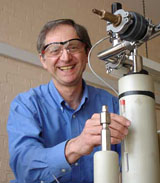Tackling cancer - from asteroids to nano-packages
Imagine you could find a possible future cure for cancer in the metals delivered to earth on the asteroid that killed the dinosaurs. Or perhaps, in the future you could send microscopic drug parcels into the body, designed to seek and destroy the cancerous cells - but only attack when the time is right.
Some stories about scientific endeavour are so amazing they may seem to be the stuff of sci-fi. But in fact these two tales are not plot ideas for the new Dr Who series - they are the real stories of research teams at the University of Warwick and they feature in two virtual reality videos narrated by Stephen Fry and Olivia Colman for the Stand Up to Cancer campaign.
In the first of the VR video series, actress Olivia Colman takes viewers on a tour through the human body, shrinking to the size of cells and following ‘nano-tech drug parcels’, demonstrating the exciting potential of this experimental new cancer treatment.
Professor Sebastien Perrier, Monash-Warwick Alliance Chair in Polymer Chemistry, and his colleagues are working towards using nanotechnology to deliver a ‘ticking time bomb’ to cancer cells.
The video shows how Professor Perrier is investigating the use of microscopic ‘packages’ to deliver chemotherapy drugs, which are synchronised with a patient’s own body clock. The nanopackages seek out cancerous cells in the body and stick to them, and then, like 'ticking timebombs' they burst open at the optimum time when healthy cells are least likely to be damaged.
In another film, presenter Stephen Fry explores the history of cancer, from its earliest known instances in dinosaurs to recent scientific developments. He describes how scientists from the University of Warwick are using a metal found in the asteroid that wiped out the dinosaurs to kill cancer cells.
Researchers from the Professor Sadler and Professor O’Connor groups in Warwick’s Department of Chemistry and Professor Hui Chao's group at Sun Yat-Sen University in China have demonstrated that iridium – the world’s second densest metal – can be used to kill cancer cells by filling them with a deadly version of oxygen, without harming healthy tissue.
The researchers created a compound of iridium and organic material, which can be directly targeted towards cancerous cells, transferring energy to the cells to turn the oxygen (O2) inside them into singlet oxygen, which is poisonous and kills the cell - but not the healthy tissue.
Stand Up To Cancer has raised £38 million since it was launched in the UK in 2012. The funding is used for clinical trials and projects which accelerate the development of new cancer treatments and tests, to help patients and ultimately save more lives. This year, Stand Up To Cancer will culminate with a night of live TV on Channel 4, on Friday, October 26.
Professor Perrier, Monash-Warwick Alliance Chair in Polymer Chemistry, said: “It’s great to get recognition for my team's work by people like Olivia Colman, as this helps to raise awareness. Our work focuses on improving the activity of anticancer drugs by ensuring they get delivered to specific locations in the body, where the disease is at its worst. It involves collaborations between many disciplines, from materials science to chemistry, biology and of course medicine. This video summarises very well how our approach works, and it is fantastic to be able to show people what their donation enables us to do. Without this support, we could not have achieved all what we have done.”
Published: 25 October 2018
 Professor Seb Perrier is the Monash and Warwick Universities Alliance Chair in Polymer Chemistry. His project is jointly funded by Cancer Research UK through the Stand Up To Cancer Campaign and the Engineering and Physical Sciences Research Council.
Professor Seb Perrier is the Monash and Warwick Universities Alliance Chair in Polymer Chemistry. His project is jointly funded by Cancer Research UK through the Stand Up To Cancer Campaign and the Engineering and Physical Sciences Research Council.
 Professor Peter Sadler's research uses metals in medicine and his lab is part of the collaboration researching iridium, funded by the Engineering and Physical Sciences Research Council.
Professor Peter Sadler's research uses metals in medicine and his lab is part of the collaboration researching iridium, funded by the Engineering and Physical Sciences Research Council.
Terms for republishing
The text in this article is licensed under a Creative Commons Attribution 4.0 International License (CC BY 4.0).
Share

